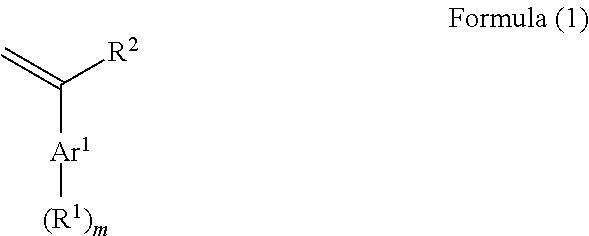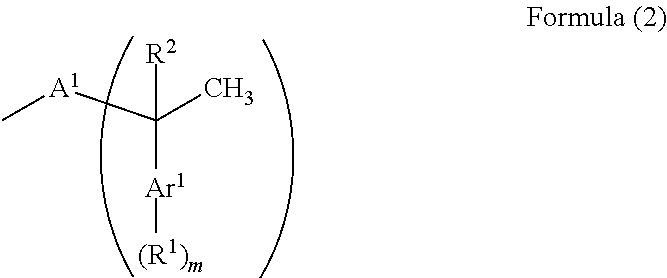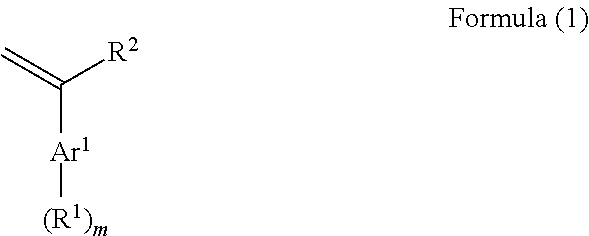Resist underlayer film-forming composition containing novolac resin to which aromatic vinyl compound is added
a technology of aromatic vinyl compound and film-forming composition, which is applied in the direction of photomechanical equipment, photosensitive material processing, instruments, etc., can solve the problems of reduced resolution, reduced stability, and severe standing wave effects, and achieve excellent spin coating properties, crosslinker and high solubility
- Summary
- Abstract
- Description
- Claims
- Application Information
AI Technical Summary
Benefits of technology
Problems solved by technology
Method used
Image
Examples
example 1
[0108]5.75 g of propylene glycol monomethyl ether and 22.98 g of propylene glycol monomethyl ether acetate were added to 7.55 g of 2-phenylindole, 9.00 g of 1-pyrenecarboxyaldehyde, 2.04 g of styrene, and 0.56 g of methanesulfonic acid, and the mixture was stirred at 130° C. for 24 hours in a nitrogen atmosphere. The reaction liquid was added dropwise to methanol, and the deposited resin was filtered out, washed, and dried under reduced pressure at 70° C. to obtain 15.61 g of resin containing a structure of Formula (4-1). The weight average molecular weight in terms of standard polystyrene measured by GPC of the resin was 1,100.
[0109]Subsequently, 1.00 g of the obtained resin and 0.002 g of surfactant (available from DIC Corporation, trade name: MEGAFACE [product name] R-40, fluorosurfactant) were dissolved in 5.70 g of propylene glycol momomethyl ether and 13.30 g of propylene glycol monomethyl ether acetate to prepare a resist underlayer film-forming composition.
example 2
[0110]5.37 g of propylene glycol monomethyl ether and 21.47 g of propylene glycol monomethyl ether acetate were added to 6.71 g of 2-phenylindole, 8.00 g of 1-pyrenecarboxyaldehyde, 2.68 g of 2-vinylnaphthalene, and 0.50 g of methanesulfonic acid, and the mixture was stirred at 130° C. for 24 hours in a nitrogen atmosphere. The reaction liquid was added dropwise to methanol, and the deposited resin was filtered out, washed, and dried under reduced pressure at 70° C. to obtain 16.42 g of resin containing a structure of Formula (4-2). The weight average molecular weight in terms of standard polystyrene measured by GPC of the resin was 1,100.
[0111]Subsequently, 1.00 g of the obtained resin and 0.002 g of surfactant (available from DIC Corporation, trade name: MEGAFACE [product name] R-40, fluorosurfactant) were dissolved in 5.70 g of propylene glycol momomethyl ether and 13.30 g of propylene glycol monomethyl ether acetate to prepare a resist underlayer film-forming composition.
example 3
[0112]6.07 g of propylene glycol monomethyl ether and 24.30 g of propylene glycol monomethyl ether acetate were added to 7.55 g of 2-phenylindole, 9.00 g of 1-pyrenecarboxyaldehyde, 3.13 g of 4-tert-butylstyrene, and 0.56 g of methanesulfonic acid, and the mixture was stirred at 130° C. for 24 hours in a nitrogen atmosphere. The reaction liquid was added dropwise to methanol, and the deposited resin was filtered out, washed, and dried under reduced pressure at 70° C. to obtain 17.60 g of resin containing a structure of Formula (4-3). The weight average molecular weight in terms of standard polystyrene measured by GPC of the resin was 1,400.
[0113]Subsequently, 1.00 g of the obtained resin and 0.002 g of surfactant (available from DIC Corporation, trade name: MEGAFACE [product name] R-40, fluorosurfactant) were dissolved in 5.70 g of propylene glycol momomethyl ether and 13.30 g of propylene glycol monomethyl ether acetate to prepare a resist underlayer film-forming composition.
PUM
| Property | Measurement | Unit |
|---|---|---|
| molar ratio | aaaaa | aaaaa |
| molar ratio | aaaaa | aaaaa |
| temperature | aaaaa | aaaaa |
Abstract
Description
Claims
Application Information
 Login to View More
Login to View More - R&D
- Intellectual Property
- Life Sciences
- Materials
- Tech Scout
- Unparalleled Data Quality
- Higher Quality Content
- 60% Fewer Hallucinations
Browse by: Latest US Patents, China's latest patents, Technical Efficacy Thesaurus, Application Domain, Technology Topic, Popular Technical Reports.
© 2025 PatSnap. All rights reserved.Legal|Privacy policy|Modern Slavery Act Transparency Statement|Sitemap|About US| Contact US: help@patsnap.com



